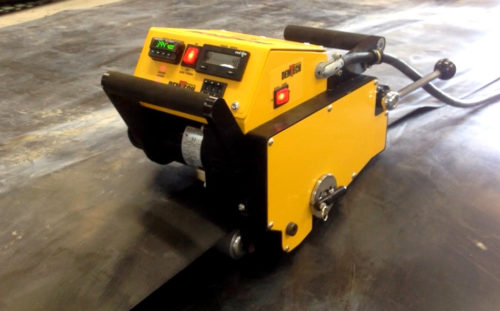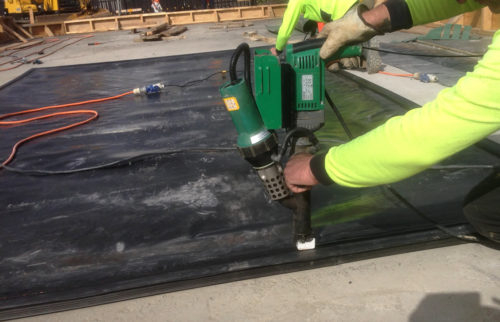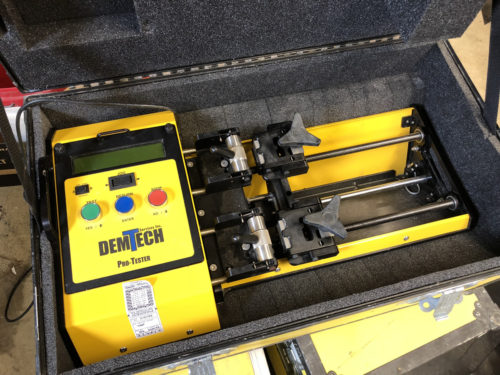Welding HDPE Liners
There are various techniques, methods and equipment used for welding HDPE Liners.
Fusion Welding
 Split Hot-Wedge Fusion welding method or known as Wedge Welding is a fully automated device comprising of a heated copper wedge, pressure rollers and electronic controls. The copper wedge is controlled and constantly monitored by a welding technician to adjust temperatures and speed of the drive unit. The copper wedge shall create a double-track weld along the length of the sheets leaving a void between the two tracks. This void is then sealed at each end with air pumped inside until it reaches 2.5 bar. The Pressure is then monitored and must hold without dropping more than the allowable 10% over 5 minutes. Any failures in the weld will be repaired by locating the point out of which the air is seeping.
Split Hot-Wedge Fusion welding method or known as Wedge Welding is a fully automated device comprising of a heated copper wedge, pressure rollers and electronic controls. The copper wedge is controlled and constantly monitored by a welding technician to adjust temperatures and speed of the drive unit. The copper wedge shall create a double-track weld along the length of the sheets leaving a void between the two tracks. This void is then sealed at each end with air pumped inside until it reaches 2.5 bar. The Pressure is then monitored and must hold without dropping more than the allowable 10% over 5 minutes. Any failures in the weld will be repaired by locating the point out of which the air is seeping.
Wedge-welding is recognized as the primary method of welding geomembranes.
Extrusion Welding
 Extrusion welding utilizes a surface Extrusion Hand Welder. It is semi-automated and equipped with electronic controls which constantly monitor outputs for both preheat and HDPE extrudate. The unit shall be capable of pre-heating the sheet just prior to the casting of HDPE extrudate over the upper and lower section of the weld zone.
Extrusion welding utilizes a surface Extrusion Hand Welder. It is semi-automated and equipped with electronic controls which constantly monitor outputs for both preheat and HDPE extrudate. The unit shall be capable of pre-heating the sheet just prior to the casting of HDPE extrudate over the upper and lower section of the weld zone.
Testing of this type of welding consists of a copper wire being attached to the welding zone before welding is carried out. Once the weld is completed, using a spark tester which creates a high voltage spark to the copper wire indicating a hole in the weld.
This method is used for all repairs and detail work where fusion welding is not possible such as penetrations through the liner or welding to polylock.
Welder Calibrations
 As well as testing each seam when completed, wedge and extrusion welds are calibrated at the beginning of each day to ensure they are set to the appropriate temperature, pressure and speed. A test weld is carried out and a sample is cut from the test weld and pulled apart on a specially designed tensiometer. This will give a reading in Newtons indicating the strength of the weld. This reading must pass the minimum strength test outlined in the liner specification.
As well as testing each seam when completed, wedge and extrusion welds are calibrated at the beginning of each day to ensure they are set to the appropriate temperature, pressure and speed. A test weld is carried out and a sample is cut from the test weld and pulled apart on a specially designed tensiometer. This will give a reading in Newtons indicating the strength of the weld. This reading must pass the minimum strength test outlined in the liner specification.
For a more detailed explanation of the processes involved in welding HDPE liners please see the scope of works.




